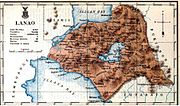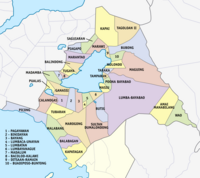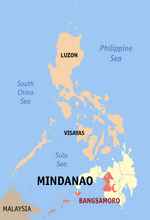Province in Bangsamoro, Philippines
Lanao del Sur (Tagalog: Timog Lanao; Meranaw and Iranun: Pagabagatan Ranao; Arabic (Kirim): لاناو الجنوبى), officially the Province of Lanao del Sur, is a province in the Philippines located in the Bangsamoro Autonomous Region in Muslim Mindanao (BARMM). The capital is the city of Marawi (the most populous in the province), and it borders Lanao del Norte to the north, Bukidnon to the east, and Maguindanao del Norte and Cotabato to the south. To the southwest lies Illana Bay, an arm of the Moro Gulf.
Situated in the interior of Lanao del Sur is Lake Lanao, the largest in Mindanao.
Etymology
"Lanao" means "lake", derived from ranao. The province, situated at basin of Lake Lanao, is known as the land of the "Maranaos" (which means "the "people of the lake").
History
Further information: Lanao (province)Early history
Prior to the arrival of Islam, the region already had a sophisticated culture, as embodied in various Maranao epics, chants, and recorded history. The people of Lanao used to adhere to Hinduism, polytheist animism, and Buddhism. During this era, various cultural icons developed, such as the torogan, the singkil dance, the darangen epic, the unique Maranao gong and metal craft culture, the sarimanok, the okir motif, and an indigenous suyat script.
Spanish colonization
Main article: Confederate States of LanaoLanao was first explored by the Spaniards in 1689, upon which they discovered a well-settled community named Dansalan at the lake's northern end. Lanao was the seat of the Sultanate of Lanao.
During the Pre-Spanish time, there were 4 important boundaries which held the power of appointing a new sultan namely: Bakayawan, Dalama, Madamba and Sawer. In appointing a new sultan the permission of these four boundaries are needed to validate the new sultan appointed to his position.
Japanese occupation
In 1942, it was occupied by the Japanese Imperial Forces who landed in Southern Lanao. On May 2, 1942, the former Chief Justice of the Supreme Court of the Philippines José Abad Santos was killed by the Japanese Imperial forces in a firing squad at Malabang, Lanao del Sur. In 1945, the first of the liberation forces landed in Southern Lanao and liberated the area with United States, Philippine Commonwealth troops together with the Maranao guerrilla units. They used infantry weapons, the Maranao Kris, Barong and Kampilan swords against the Japanese forces in the Battle of Lanao.
Philippine independence
In 1956, Republic Act No. 1552 changed the name Dansalan to Marawi, taken from the word rawi, referring to the reclining lilies abundant in the Agus River.

Division
In 1959, Lanao was divided into two provinces, Lanao del Norte and Lanao del Sur, under Republic Act No. 2228. Marawi was designated as the capital of Lanao del Sur. The city was renamed the "Islamic City of Marawi" in 1980, and is currently the Philippines' only city having a predominantly Muslim population.
Proposed Maranaw province
In 1971, Republic Act No. 6406, which sought to create a new province out of eastern Lanao del Sur (now corresponding to the province's first congressional district), was approved on October 4, 1971. The province was to consist of the municipalities of Bubong, Ditsaan-Ramain (including what is now Buadiposo-Buntong), Kapai, Lumba-Bayabao (including what is now Maguing), Marantao, Masiu, Mulondo, Saguiaran, Piagapo, Poona Bayabao, Tamparan, Taraka and Wao (including what is now Bumbaran), with the chartered city of Marawi serving as the new provincial capital. The division never took place due to the declaration of Martial law in the Philippines on September 21, 1972, which disrupted the elections for 1973.
Inclusion to the ARMM
In a 1989 plebiscite, Lanao del Sur voted to join the Autonomous Region in Muslim Mindanao (ARMM), but the city of Marawi voted to remain outside the ARMM. It later joined ARMM in 2001 following the plebiscite that sought to expand the autonomous region.
Contemporary
The Battle of Marawi began and ended in 2017. The battle was against ISIL-affiliated militants, a number of which were Malaysian citizens. The battle destroyed most of the cityscape of Marawi and killed hundreds of civilians and Filipino soldiers.
A petition was released in support for the usage of the torogan as inspiration for the rehabilation of Marawi after the Battle of Marawi. The petition was released in opposition to the possible Manila Rehabilation Effect that the government plans to impose. The Manila-style rehabilation would establish shanty houses and buildings without Maranao architectural styles, thus destroying Marawi's Maranao cultural skyline. The petition advocates a Warsaw-style Rehabilation Effect, where the culture and styles of a particular area is used as foundation for rehabilitation of built heritage and landscape. Among the local architectural styles that may be used under the Warsaw-style are the okir, sarimanok, and inspirations from the torogan. The Warsaw-style is also foreseen to boost tourism in the city in the long-run due to the cultural aesthetics it would bring.
Governors after People Power Revolution
- 1988–1992, Saidamen Balt Pangarungan
- 1992–2001, Mahid Mutilan
- 2001–2004, Mamintal A. Adiong, Sr.
- 2004–2007, Basher Dimalaang Manalao
- 2007–2016, Mamintal Alonto Adiong Jr.
- 2016–2019, Soraya Alonto Adiong
- 2019–present, Mamintal Alonto Adiong Jr.
Geography

Lanao del Sur is bounded on the north by Lanao del Norte, on the east by Bukidnon, on the west by Illana Bay, and on the south by Maguindanao del Norte and Cotabato. The landscape is dominated by rolling hills and valleys, placid lakes and rivers.
Located within the province is Lanao Lake, the second largest in the country, its waters drained by the Agus River which eventually empties into Iligan Bay.
The climate in the province is characterized by even distribution of rainfall throughout the year, without a distinct summer season. The province is located outside the typhoon belt.
Administrative divisions
Lanao del Sur comprises 39 municipalities and 1 city.

- † Provincial capital and component city
- Municipality
Demographics
| Year | Pop. | ±% p.a. |
|---|---|---|
| 1903 | 13,811 | — |
| 1918 | 65,531 | +10.94% |
| 1939 | 144,010 | +3.82% |
| 1948 | 212,312 | +4.41% |
| 1960 | 378,327 | +4.93% |
| 1970 | 455,508 | +1.87% |
| 1975 | 499,882 | +1.88% |
| 1980 | 404,971 | −4.12% |
| 1990 | 599,637 | +4.00% |
| 1995 | 686,193 | +2.56% |
| 2000 | 800,162 | +3.35% |
| 2007 | 1,138,544 | +4.98% |
| 2010 | 933,260 | −6.98% |
| 2015 | 1,045,429 | +2.19% |
| 2020 | 1,195,518 | +2.67% |
| Source: Philippine Statistics Authority | ||
The population of Lanao del Sur in the 2020 census was 1,195,518 people, with a density of 310 inhabitants per square kilometre or 800 inhabitants per square mile.
The majority of people in the province are Maranaos, while some are Cebuanos, Ilocanos, Bicolanos, Hiligaynons, Kapampangans, Tagalogs, Maguindanaons, Iranuns, Higaonons, Zamboangueños, Tausugs, Yakans, and Sama.
Maranao is the most commonly spoken language in the province. Iranun is the native language of most of the inhabitants of the municipality of Kapatagan. Also spoken are Maguindanao, Cebuano, and Chavacano followed by Tagalog and English. Minority languages such as Hiligaynon, Ilocano, Kapampangan, Higaonon are also spoken
Religion
| Religion in Lanao del Sur (2020) | ||||
|---|---|---|---|---|
| Religion | percentage | |||
| Islam | 94.7% | |||
| Christianity (chiefly Roman Catholic) | 5.2% | |||
| Others | 0.1% | |||
Most of the people of Lanao del Sur are practitioners of Islam. The majority of them are Sunni. The number of Muslims in this province is 1,131,726 or nearly 95% of the total population of the province of Lanao del Sur.
Economy
Poverty incidence of Lanao del Sur
|
10
20
30
40
50
60
70
80
2006 44.72 2009 56.59 2012 73.77 2015 77.09 2018 71.16 2021 7.40 Source: Philippine Statistics Authority |
Education
- Mindanao State University, located in Marawi City
- Mindanao State University – Lanao National College of Arts and Trades, located in Panggao Saduc, Marawi City
- Jamiatu Muslim Mindanao, located in Matampay, Marawi City
- Jamiatul Philippine Al-Islamia, located in Bangon, Marawi City
- RC - Al Khwarizmi International College Foundation, Inc., located in Basak Malutlut, Marawi City
- Adiong Memorial State College, located in Ditsaan-Ramain, Lanao del Sur
- Lanao Agricultural College, located in Lumbatan, Lanao del Sur
- Philippine Muslim Teachers' College
- Adiong Memorial College Foundation, Inc. , located in Wao, Lanao del Sur
- Philippine Engineering and Agro-Industrial College, Inc., located in Lomidong, Marawi City
- Balabagan Trade School, located in Balabagan, Lanao del Sur
- Iranun Foundation College, Incorporated, located in Kapatagan, Lanao del Sur
- Lanao Central College, Incorporated, located in East Basak, Marawi City
Hospitals
Public
- Amai Pakpak Medical Center
- Marawi City General Hospital
- MSU Medical Services and Hospital (University Infirmary)
- Balindong District Hospital, located in Brgy. Salipongan, Balindong, Lanao del Sur
- Unayan District Hospital, located in Brgy. Pagalamatan, Binidayan, Lanao del Sur
- Dr. Serapio B. Montañer Jr. Al Haj Memorial Hospital, located in Brgy. Mabul, Malabang, Lanao del Sur
- Wao District Hospital, located in Brgy. Western Wao (Pob.), Wao, Lanao del Sur
- Tamparan District Hospital, located in Brgy. Picarabawan, Tamparan, Lanao del Sur
Private
- Dr. Abdullah Hospital Foundation, Inc.
- Marawi Midtown Hospital
- Al-Shiek Hospital
- Sala'am Hospital Foundation, Inc.
- Ranao Doctors Polyclinic
- Mindalano Specialist Hospital Foundation, Inc.
- Hijrah Specialist Hospital, located in Brgy. Marawi Poblacion, Marawi
- Hijrah Hospital, located in Brgy. Daanaingud, Marantao, Lanao del Sur
- Tamparan Medical Foundation Inc. Hospital, located in Brgy. Picarabawan, Tamparan, Lanao del Sur
UNESCO Designations in Lanao del Sur
UNESCO has inscribed one Maranao element, the Darangen Chants of the Maranao People of Lake Lanao, in the Representative List of the Intangible Cultural Heritage of Humanity in 2008. The element was earlier inscribed in the UNESCO Oral and Intangible Heritage of Humanity Representative List in 2005. The organization has also designated the Old Town of Tugaya as a UNESCO Home for Culture and Heritage. UNESCO has recommended for the nomination of Tugaya and all of Lanao del Sur's traditional crafts heritage in Representative List of the Intangible Cultural Heritage of Humanity, following reports made in 2014 and 2015. The Philippine ambassador to UNESCO and France noted that it will be better to inscribe Maranao's traditional crafts in the List of Intangible Cultural Heritage in Need of Urgent Safeguarding as they have been endangered due to the 2017 Battle of Marawi. The nomination is being finalized by the Philippine government, as announced in 2018. The torogans of Lanao are also recommended by UNESCO to be nominated in the World Heritage List once proper documentation and restoration has been completed. Two torogans have been bought by a controversial heritage resort company, Las Casas Filipinas de Acuzar, and were transported to Bataan, sparking a provincial campaign to get back the two royal houses to their ancestral homeland.
References
- Autonomous Region in Muslim Mindanao, Department of Agriculture: Lanao del Sur Archived January 19, 2015, at the Wayback Machine (There are major discrepancies among authoritative sources: 4121.3 km² (NAMRIA); 1,349,437 ha (NSCB, this value seems unreasonable and must be assumed as erroneous, see Talk:Lanao del Sur#Area))
- ^ Census of Population (2020). Table B - Population and Annual Growth Rates by Province, City, and Municipality - By Region. Philippine Statistics Authority. Retrieved July 8, 2021.
- ^ Lancion, Conrado M. Jr. (1995). "The Provinces; Lanao del Sur". Fast Facts about Philippine Provinces. cartography by de Guzman, Rey (The 2000 Millennium ed.). Makati, Metro Manila, Philippines: Tahanan Books. pp. 94–95. ISBN 971-630-037-9. Retrieved December 25, 2015.
- "National Commission for Culture and the Arts".
- "The Traditional Dance of Lanao del Sur, on the Spotlight in Teleserye Wildflower – Choose Philippines. Find. Discover. Share". July 8, 2021. Archived from the original on February 6, 2018.
- "Republic Act No. 1552 - An Act to Amend the Charter of the City of Dansalan So as to Change Its Name to Marawi and Make Elective Its Mayor, Vice Mayor and Councilors, and for Other Purposes". Chan Robles Virtual Law Library. Retrieved December 25, 2015.
- "Republic Act No. 2228 - An Act to Create the Provinces of Lanao del Norte and Lanao del Sur". Chan Robles Virtual Law Library. Retrieved December 25, 2015.
- "Republic Act No. 6406 - An Act Dividing the Province of Lanao del Sur into the Province of Maranaw and Lanao del Sur". Chan Robles Virtual Law Library. Retrieved December 25, 2015.
- ^ "Province: Lanao del Sur". PSGC Interactive. Quezon City, Philippines: Philippine Statistics Authority. Retrieved January 8, 2016.
- ^ Census of Population (2015). Highlights of the Philippine Population 2015 Census of Population. Philippine Statistics Authority. Retrieved June 20, 2016.
- Census of Population and Housing (2010). Population and Annual Growth Rates for The Philippines and Its Regions, Provinces, and Highly Urbanized Cities (PDF). National Statistics Office. Retrieved June 29, 2016.
- Census of Population and Housing (2010). "ARMM – Autonomous Region in Muslim Mindanao" (PDF). Total Population by Province, City, Municipality and Barangay. National Statistics Office. Retrieved June 29, 2016.
- "Religious Affiliation in the Philippines (2020 Census of Population and Housing) | Philippine Statistics Authority | Republic of the Philippines". psa.gov.ph. Retrieved August 6, 2023.
- Michael Bueza (July 17, 2015). "MAP: Islam in the Philippines". www.rappler.com. Retrieved July 10, 2022.
- "Poverty incidence (PI):". Philippine Statistics Authority. Retrieved December 28, 2020.
- "Estimation of Local Poverty in the Philippines" (PDF). Philippine Statistics Authority. November 29, 2005.
- "2009 Official Poverty Statistics of the Philippines" (PDF). Philippine Statistics Authority. February 8, 2011.
- "Annual Per Capita Poverty Threshold, Poverty Incidence and Magnitude of Poor Population, by Region and Province: 1991, 2006, 2009, 2012 and 2015". Philippine Statistics Authority. August 27, 2016.
- "Annual Per Capita Poverty Threshold, Poverty Incidence and Magnitude of Poor Population, by Region and Province: 1991, 2006, 2009, 2012 and 2015". Philippine Statistics Authority. August 27, 2016.
- "Annual Per Capita Poverty Threshold, Poverty Incidence and Magnitude of Poor Population, by Region and Province: 1991, 2006, 2009, 2012 and 2015". Philippine Statistics Authority. August 27, 2016.
- "Updated Annual Per Capita Poverty Threshold, Poverty Incidence and Magnitude of Poor Population with Measures of Precision, by Region and Province: 2015 and 2018". Philippine Statistics Authority. June 4, 2020.
- "2021 Full Year Official Poverty Statistics of the Philippines" (PDF). Philippine Statistics Authority. August 15, 2022. Retrieved April 28, 2024.
- "Art installations inaugurate art space at controversial Acuzar 'heritage resort' in Bataan". May 26, 2013.
External links
Map all coordinates using OpenStreetMapDownload coordinates as:
 Media related to Lanao del Sur at Wikimedia Commons
Media related to Lanao del Sur at Wikimedia Commons Geographic data related to Lanao del Sur at OpenStreetMap
Geographic data related to Lanao del Sur at OpenStreetMap- Philippine Census Information
- Local Governance Performance Management System
| Places adjacent to Lanao del Sur | ||||||||||||||||
|---|---|---|---|---|---|---|---|---|---|---|---|---|---|---|---|---|
| ||||||||||||||||
| Marawi (capital) | |
| Municipalities |
|
| Component city | |
| Articles related to Lanao del Sur | ||||||||||||||||||||||||||||||||||||||||||||||||||||||
|---|---|---|---|---|---|---|---|---|---|---|---|---|---|---|---|---|---|---|---|---|---|---|---|---|---|---|---|---|---|---|---|---|---|---|---|---|---|---|---|---|---|---|---|---|---|---|---|---|---|---|---|---|---|---|
| ||||||||||||||||||||||||||||||||||||||||||||||||||||||








